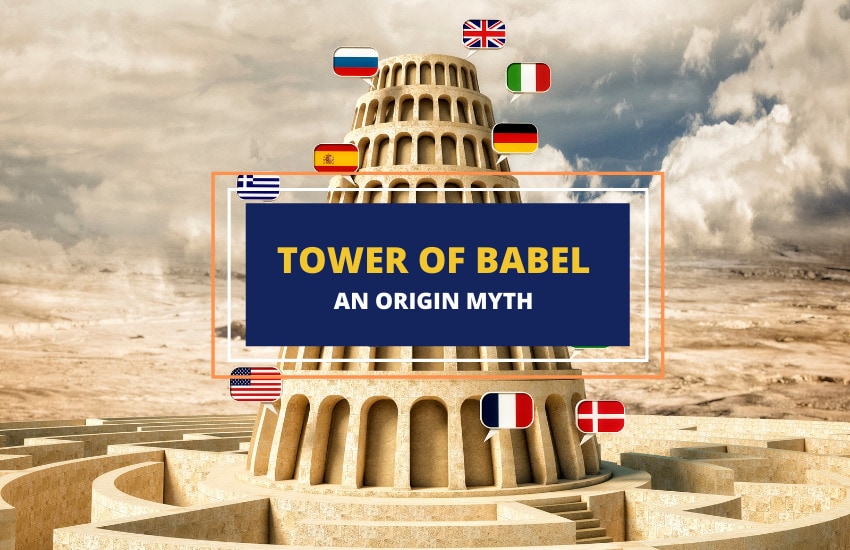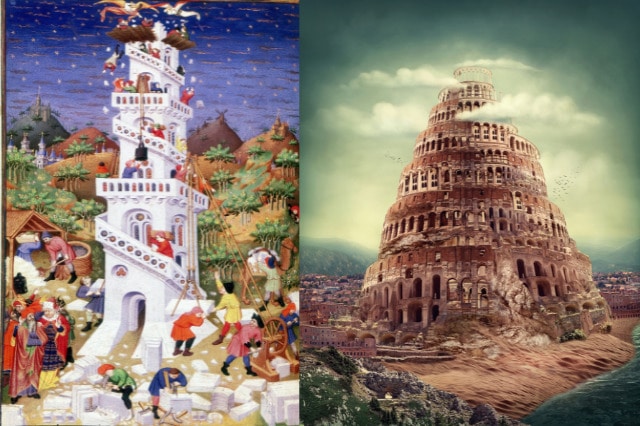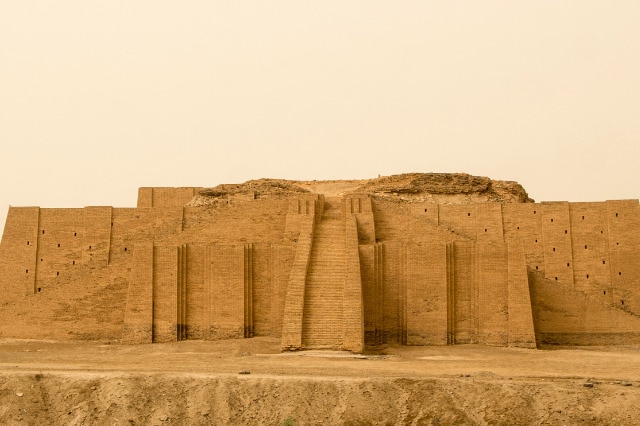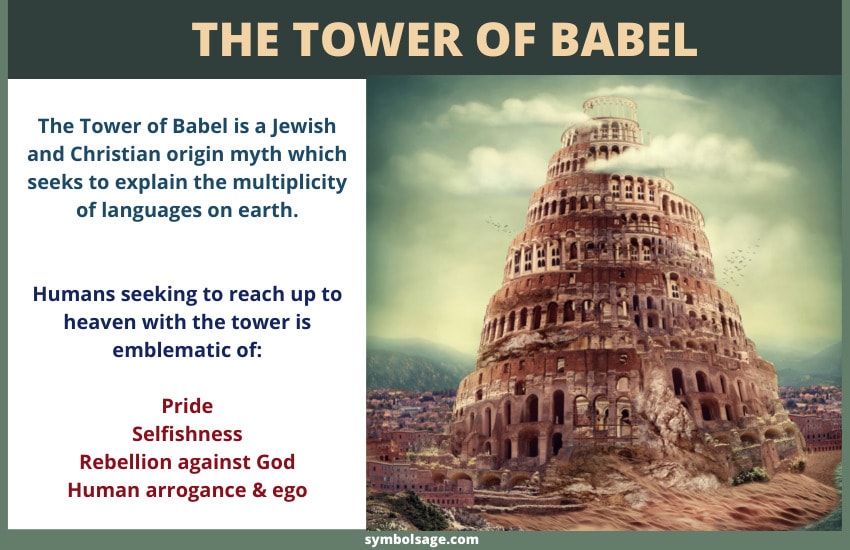
Table of Contents
The Tower of Babel is a Jewish and Christian origin myth which seeks to explain the multiplicity of languages on earth. The narrative is found in Genesis 11:1-9. This places the story chronologically after the Great flood and before Abraham encounters God.
Some scholars discount it as inauthentic, based on the argument that it is asynchronous with the verses immediately preceding it. However, this is unnecessary since the story can also be read as an explanation for the summary of the post-flood spread of peoples throughout the earth.
Origins of the Tower of Babel Myth

The phrase “Tower of Babel” does not occur in the Biblical story. Rather, the tower is in the process of being built in the middle of a new city also under construction. It is not until after the Lord confuses the languages that the city is referred to as Babel, meaning confused or mixed.
There is textual, archaeological, and theological evidence that the city of Babel in this story is one and the same with the city of Babylon, which plays an important role in the history of the Hebrews.
The textual evidence for Babel being synonymous with Babylon is found in chapter 10 verses 9-11. As the author gives the genealogy of Noah’s sons and how their descendants fathered nations, he comes to a man named Nimrod. Nimrod is described as the first of “to be a mighty man”. This seems to mean that he was a great leader and ruler.
The extent of his kingdom is quite vast, and he is responsible for the building of several prominent ancient cities, including Nineveh and Babel. Babel is placed within a land called Shinar, which puts the city in the same location as Babylon.
Archeological Evidence for the Tower of Babel

While the tower takes on many shapes and forms in art history, archeologists identify it with the ziggurats common in this part of the ancient world.
Ziggurats were stepped pyramid shaped structures essential to the worship of gods in ancient Mesopotamian cultures. The existence of such a structure in Babylon is attested to by numerous historical accounts.
Known as Etemenanki, this ziggurat was dedicated to the god Marduk, the chief God of the Babylonian empire. Etemananki was old enough to have been rebuilt by King Nebuchadnezzer II, and was still standing, though it had fallen into disrepair, at the time of Alexander’s conquest. The archeological site of Etemenanki is located some 80 miles outside of Baghdad, Iraq.
Like the story of the flood, the story of the tower of babel has similarities with myths found among other ancient cultures.
- In Greek and then Roman mythology, the gods fought a battle with giants for supremacy. The giants attempted to reach the gods by piling up mountains. Their attempt was undone by Jupiter’s thunderbolts.
- There is a Sumerian tale of king Enmerkar building an enormous ziggurat and at the same time praying for the reuniting of people under a single language.
- Several stories similar to Babel exist among the cultures of the Americas. One of them is centered around the building of the Great Pyramid at Cholula, the largest pyramid in the new world. The story is told of it also being built by giants but destroyed by the gods.
- The Toltecs, predecessors to the Aztecs also have a similar myth as did the Cherokee.
- Similar stories have also been traced to Nepal.
- David Livingston attested to something similar among the tribes he encountered in Botswana.
Although Islam has much in common with fellow Abrahamic religions of Judaism and Christianity, the Qur’an does not include the story of Babel. It does, however, tell a somewhat related story.
According to Sura 28:38, during the time of Moses, the Pharaoh requested of his chief adviser Haman a tower to be built to heaven. This was so that he could climb up to the God of Moses, because “as far as I am concerned, I think Moses is a liar”.
Theological Importance of the Tower of Babel
There are several important implications of the Tower of Babel for Jewish and Christian theology.
First, it re-enforces the myth of creation and origin of the world. As with the creation of the universe, earth, and all its life forms, along with the existence of sin and death, the numerous cultures, people, and languages of earth are due to the intentional acting of God. There are no accidents. Things do not simply occur naturally, and it was not the unintended consequence of a cosmic battle between gods. The one God is in control of all that occurs on earth.
Not surprisingly then there are several echoes of the Garden of Eden in this narrative. Once again God comes down despite humans’ attempt to reach him. He walks on earth and looks upon what is being done.
This story also fits into a recurring narrative arc in the book of Genesis moving from one man to several people and then focusing back to one man again. A cursory view of this concept goes as follows:
Adam is fruitful and multiplies to populate the earth. Then the flood caused by sin moves humanity back to one godly man, Noah. His three sons repopulate the earth, until people were again scattered at Babel due to their sin. From there the narrative focuses on one godly man, Abraham, from which will come descendants “as numerous as the stars”.
The theological and moral lessons of the Tower of Babel can be retold in various ways, but in general it is viewed as the consequence of human pride.

Symbolism of the Tower of Babel
After the flood, humans had the opportunity to rebuild, though from the outset it was obvious that sin was not washed away by the water (Noah got drunk and his son Ham was cursed for seeing his father naked).
Still, people multiplied and built a new society with the invention of fired clay bricks. Yet, they quickly turned away from worshipping and honoring God, trading that in for self-exaltation, making a name for themselves.
Seeking to reach up to heaven with the tower is emblematic of their desire to take God’s place and serve their own desires rather than serving their Maker. In order to prevent this from happening God confused their languages so that they could no longer work together and had to separate.
Other lesser moral and theological implications also exist. One of these may be that the reason God caused the confusion in languages is because he did not intend for them to stay together. By building this united society, they were failing to fulfill the command to be fruitful, multiply, and fill the earth. This was God’s way of forcing them to go about the task they were given.
In Brief
The story of the Tower of Babel still resonates in cultures today. It appears from time to time in television, film, and even video games. Usually, the tower represents the forces of evil.
Though it is considered by most scholars to be pure myth, it has several important teachings to understand the Judeo-Christian view of the world and of the character of God. He is not distant or disinterested in the activities of men. He acts in the world according to his design and to bring about his ends by acting in people’s lives.








